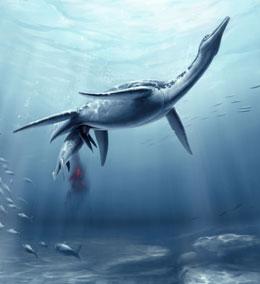Science News
Plesiosaur Pregnancy

For 33 years, a fossilized plesiosaur remained safely hidden away in the basement of the Natural History Museum of Los Angeles County—ever since its discovery in Logan County, Kansas. Sadly, it can no longer hide. Now scientists and the media are accusing it of being pregnant, showing “mother love,” and worse, cannibalism! Talk about tabloid fodder.
A new study, published in this week’s Science, describes the 78-million-year-old, 15 foot adult specimen as a Polycotylus latippinus, one of the giant, carnivorous, four-flippered reptiles known as plesiosaurs that lived during the Mesozoic Era. An embryonic skeleton appears to be contained within and shows much of the developing body, including ribs, 20 vertebrae, shoulders, hips and paddle bones.
The authors of the study establish that these dual fossils provide the first evidence that plesiosaurs gave birth to live young, rather than hatching their offspring from eggs on land.
Live birth (or viviparity) has been documented in several other groups of Mesozoic aquatic reptiles, including ichthyosaurs, mosasaurs, and choristoderans. Although researchers suspected viviparity in plesiosaurs, no previous evidence could confirm their suspicions.
Lead author F. Robin O’Keefe explains:
Scientists have long known that the bodies of plesiosaurs were not well suited to climbing onto land and laying eggs in a nest. So the lack of evidence of live birth in plesiosaurs has been puzzling. This fossil documents live birth in plesiosaurs for the first time, and so finally resolves this mystery. Also, the embryo is very large in comparison to the mother, much larger than one would expect in comparison with other reptiles.
The other Mesozoic aquatic live-birthers had several, small offspring at one time. Plesiosaurs’ single, large progeny lead the researchers to suspect other social behavior from the marine reptile. Ed Yong discusses this in his Discover blog:
O’Keefe and [co-author Luis] Chiappe think that modern dolphins and other toothed whales come closest to recapping the plesiosaur’s reproductive habits. They too give birth to one large, well-developed infant at a time.
Whales and dolphins also live in tight social groups, and they care for their young for a long time after birth. O’Keefe and Chiappe wonder if the plesiosaurs did too. Among modern reptiles, there are virtually no species that give birth to small numbers of large, live young, like the plesiosaurs did. It is perhaps telling that the only exceptions to this rule – a group of Australian skinks – also live in groups and also look after their young.
But not everyone believes that plesiosaurs were social, loving moms. ScienceNOW reports:
Kenneth Carpenter, a paleontologist at Utah State University in Price, however, doesn’t think Poly should get the mom of the year award just yet. The young reptile in her abdomen is missing a few bones, and he suspects that Poly lopped them off when she started to chow down. Many modern-day reptiles similarly feast on juveniles, even those from the same species: “This is a stronger case for cannibalism than it is for live birth.”
Image: S. Abramowicz/NHM